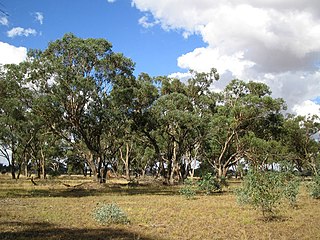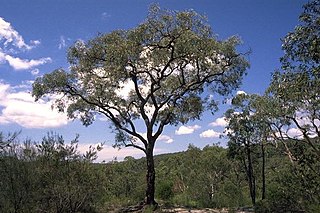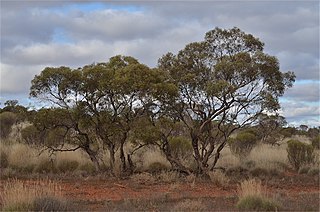
Eucalyptus coolabah, commonly known as coolibah or coolabah, is a species of tree and is found in eastern inland Australia. It has rough bark on part or all of the trunk, smooth powdery cream to pink bark above, lance-shaped to curved adult leaves, flower buds in groups of seven and hemispherical or conical fruit.

Eucalyptus olida is a species of small to medium-sized tree that is endemic to a restricted area of New South Wales. It has rough, flaky and fibrous bark on the trunk and larger branches, lance-shaped to curved adult leaves, flower buds in groups of seven to fifteen or more, white flowers and barrel-shaped or bell-shaped fruit.

Eucalyptus dumosa, commonly known as the white mallee, dumosa mallee, or Congoo mallee, is a species of mallee that is endemic to south eastern Australia. It usually has rough, flaky grey bark on the lower trunk, smooth bark above, lance-shaped to curved adult leaves, flower buds in groups of seven, white flowers and cup-shaped, cylindrical or barrel-shaped fruit.

Eucalyptus microcarpa, commonly known as grey box, is a species of tree that is endemic to southeastern continental Australia. It has rough, fibrous or flaky bark on the trunk, smooth whitish bark above, lance-shaped adult leaves, flower buds in groups of between seven and eleven, white flowers and oval, cylindrical or urn-shaped fruit.

Eucalyptus largiflorens, or black box, is a tree that is endemic to Australia. It has rough, fibrous or flaky bark, dull greenish-grey, lance-shaped leaves, oval to club-shaped green to yellow flower buds, white flowers and hemispherical, cup-shaped or barrel-shaped fruit.

Eucalyptus quadrangulata, commonly known as the white-topped box or coast white box, is a species of small to medium-sized tree that is endemic to eastern Australia. It has rough, fibrous or flaky bark on the trunk and branches, lance-shaped to curved adult leaves, flower buds in groups of seven, white flowers and conical fruit.

Eucalyptus conica, commonly known as fuzzy box, is a species of tree endemic to eastern Australia. It has rough, flaky bark on the trunk and larger branches, smooth above, lance-shaped adult leaves, oval to diamond-shaped flower buds mostly arranged on a branching inflorescence on the ends of the branchlets, white flowers and conical fruit.

Eucalyptus squamosa, commonly known as scaly bark, is a species of small to medium-sized tree that is endemic to the Sydney region in New South Wales. It has rough, tessellated, fibrous or flaky bark, lance-shaped or curved adult leaves, flower buds in groups of seven, nine or eleven, white flowers and cup-shaped or hemispherical fruit.

Eucalyptus andrewsii, commonly known as the New England blackbutt, is a tree native to New South Wales and Queensland in eastern Australia. It is a tree with rough bark on the trunk and larger branches, lance-shaped often curved leaves, flower buds in groups of between eleven and fifteen and hemispherical or cup-shaped fruit.

Eucalyptus intertexta, commonly known as inland red box, western red box, gum coolibah or the bastard coolibah, is a species of tree that is endemic to central Australia. It has rough, fibrous or flaky bark on the base of the trunk, smooth white to brownish bark above, lance-shaped adult leaves, flower buds in groups of seven on the ends of branchlets, white flowers and cup-shaped to hemispherical fruit.

Eucalyptus rudderi, or Rudder's box, is a species of tree that is endemic to northern New South Wales. It has rough fibrous or flaky bark on the trunk and branches, lance-shaped adult leaves, flower buds in groups of seven, white flowers and barrel-shaped or hemispherical fruit.
Eucalyptus nigrifunda, commonly known as desert wandoo, is a species of tree that is endemic to a small area in central Western Australia. It has smooth reddish brown bark with some rough, flaky black bark near the base of the trunk, lance-shaped adult leaves, flower buds in groups of nine, white flowers and cylindrical to barrel-shaped fruit.

Eucalyptus platycorys, commonly known as Boorabbin mallee, is a species of mallee, rarely a small tree, that is endemic to Western Australia. It has rough, dark grey, fibrous and flaky bark on the trunk, smooth greyish bark above, lance-shaped adult leaves, flower buds usually in group of three, creamy white flowers and cup-shaped to cylindrical fruit.

Eucalyptus decorticans, commonly known as the gum-top ironbark, is a species of tree that is endemic to Queensland. It has rough, dark grey or black "ironbark" on the trunk and larger branches, smooth white bark on the thinner branches, lance-shaped to curved adult leaves, flower buds in groups of seven, white flowers and conical, cup-shaped or barrel-shaped fruit.
Eucalyptus hawkeri is a species of mallee or slender tree that is endemic to Victoria, Australia. It has rough, flaky or fibrous bark on the lower trunk, smooth bark above, lance-shaped or curved adult leaves, flower buds in groups of between seven and eleven, white flowers and cylindrical or barrel-shaped fruit.

Eucalyptus microneura, commonly known as Gilbert River box, is a species of small to medium-sized tree that is endemic to Queensland. It has rough, fibrous or flaky bark on the trunk and branches, lance-shaped adult leaves, flowers in groups of seven on a branching peduncle, white flowers and conical fruit.
Eucalyptus provecta is a species of small tree that is endemic to Queensland. It has rough, fibrous to flaky bark on the trunk and branches, lance-shaped adult leaves, flower buds in groups of seven on the ends of branchlets, white flowers and cup-shaped fruit.
Eucalyptus pyrenea, commonly known as Pyrenees gum, is a species of tree that is endemic to Victoria, Australia. It has smooth, greyish bark with rough, fibrous bark on the lower part of the trunk, lance-shaped to curved adult leaves, flower buds in groups of seven, white flowers and cup-shaped fruit.
Eucalyptus silvestris is a species of mallee or small tree that is endemic to Victoria, Australia. It has rough, fibrous or flaky bark on the trunk and larger branches, smooth greyish brown bark above, glossy green, lance-shaped leaves, flower buds usually in groups of seven, white flowers and conical to cup-shaped fruit.

Eucalyptus socialis subsp. socialis, commonly known as the summer red mallee, is a subspecies of mallee that is endemic to inland south-eastern Australia. It usually has rough bark on the base of the trunk, smooth bark above, lance-shaped adult leaves, flower buds in groups of between seven and eleven, pale creamy white flowers and barrel-shaped to urn-shaped or spherical fruit.

















